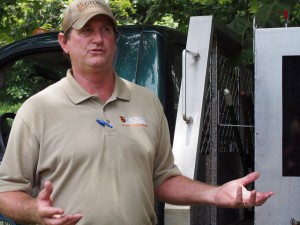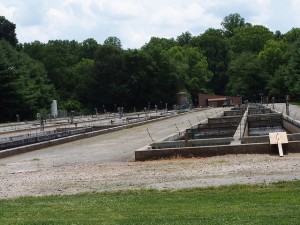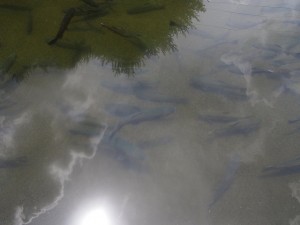
Do you enjoy fishing? How about a dinner of fresh mountain trout? Trout require a special environment: cold water and swiftly moving water. If the water is too warm (much about 55 degrees F), they will become stressed. Moving water is aerated increasing the oxygen which is also vital to trout. Because of this, trout are found in higher altitude streams and further north. However, we have a very unique situation in our area (Metro Atlanta, GA). As we saw in the last post, Buford Dam over the Chattahoochee River creates Lake Lanier. The water in Lake Lanier is about 170 feet deep at the deepest point, which is right near the dam. Because the water is so deep here, the sunlight does not penetrate past the surface zone. The intake penstocks through Buford Dam are deep in the lake, so the colder water is what passes through the dam.
So what does this mean for our backyard fish? The water in Chattahoochee River from Buford Dam south to downtown Atlanta is cold enough for trout. In fact, Atlanta is the furthest south you can catch trout. Before the installation of Buford Dam, the trout habitat only extended to Helen, GA. To meet the demand for trout fishing, the Buford Trout Hatchery raises and stocks trout right off of the Chattahoochee River. This used to be a true hatchery where trout were raised from spawn until release. However these days, the Buford Trout Hatchery acquires fingerlings (trout that are about 3-4 inches long). They then tend to the fish in a series of raceways until they reach a size of 9.5 inches. The trout are then released into the Chattahoochee River and other streams in North Georgia. The Buford Trout Hatchery raises both rainbow trout and brown trout. The hatchery has a 70% survival rate from egg to 3 inches. In nature, the survival rate is only 1-2%. Did you know that brown trout and rainbow trout are not native to Georgia? Georgia only has one native trout species: the brook trout. Brook trout are only found in mountain streams. They are much smaller than brown trout and rainbow trout.

The Buford Trout Hatchery is open to the public. It is a great place to learn about the life cycle of trout and the importance of our unique Chattahoochee River environment. Next time you are looking for something to do locally, why don’t you go check out your backyard fish? There are guided tours every Saturday at 1 pm, but you can visit any day from 7:30 am to 4:30 pm. There is even a family fishing pond on site.

Creeks to Coast Day 2, July 10, 2014, Buford Trout Hatchery